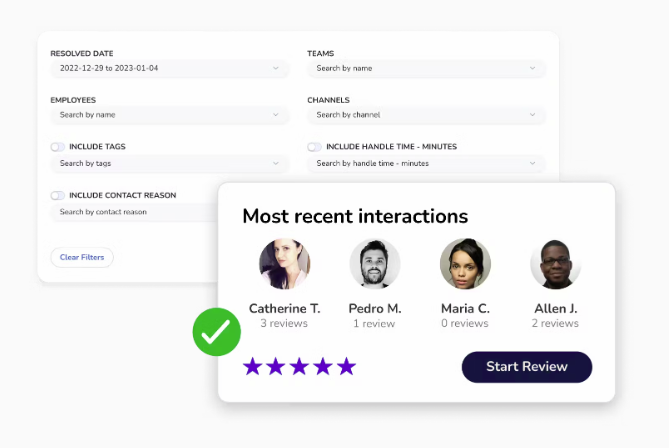The best quality assurance programs are designed to keep customer service agents informed about the standards they should strive to meet, the steps they can take to improve, and how they’re doing on an ongoing basis.
For QA managers looking to rate their team’s performance and ensure their QA program is optimized to drive important customer experience KPIs like customer satisfaction (CSAT), Net Promoter Score (NPS), and more, we’re outlining the five most important questions you need to keep in mind when measuring the success of your QA program.
By looking at your quality assurance program through the lens of these questions, you’ll be able to measure the effectiveness of your program, hold your QA team and processes accountable, and meet customer expectations.
After all, most customers today believe great customer experiences start with great interactions with employees. Meanwhile, less than half (38%) of U.S. consumers say the employees they engage with are meeting their needs.
5 Considerations to Run a Successful Quality Assurance Program
#1: How ‘rich’ is your internal feedback?
Too often when QA reviews are conducted, results get shared with agents without obvious next steps. A high QA score doesn’t mean much to your agent if they don’t know why their interactions are being scored well.
Similarly, a low QA score without any additional insight can ultimately be detrimental to an agent’s performance. After all, if they’re doing to be scored low and not told how to improve, why bother?
The best QA reviews provide both quantitative scores and qualitative feedback, with specific details that provide context beyond just the number or rating, so employees understand their performance and the specific actions they can take to improve, if needed.

When considering how ‘rich’ your internal feedback is, consider how detailed you can get when doing QA reviews. Do you have the ability to pinpoint specific moments in each call, chat, or email exchange and annotate them with best practices? Can you leave comments on interactions more broadly that speak to the overall performance of the agent?
Indeed, the more meaningful the feedback, the more actionable it becomes for your agents and the more clear direction they have for how to handle similar situations as they arise.
#2: How frequently are you performing QA reviews?
If you want to know how many reviews each team member is getting each week, you need to turn the frequency of QA reviews into a trackable KPI.
Frequency is important because QA programs fail to live up to their promise of helping companies deliver on customer centricity when there’s insufficient data provided.
Jennifer Grim, Director of Customer Service at UncommonGoods, an online marketplace connecting makers and their creations with individuals looking for truly special goods, explained that infrequent QA audits can be misleading.
When QA team leaders have only a handful of random interactions to review each week, they won’t get a clear picture of individual agents’ overall performance, how the team as a whole is doing, and where there are opportunities to provide more training and address underlying and recurring customer questions, concerns, and issues.
Before partnering with Stella Connect, experience-booking platform Peek.com managed to audit about 4 to 4.5 percent of its service exchanges, leaving the team with an incomplete snapshot of customer service performance.
Within two months of launching Stella Connect’s QA tool, the company was able to drive a 5X increase in QA audit efficiency to review up to 22% of interactions and increase their CSAT scores from 3.0 to 3.25, without growing the QA team.
Is your QA program moving the needle to drive customer satisfaction and agent improvement? Download our Guide to Doing Contact Center QA The Right Way for insight into building a streamlined, actionable QA program.
#3: How long is the turnaround time for internal quality reviews?
To run a successful quality assurance program, it’s critical to know how long it’s taking between the completion of a given customer interaction, and when a QA review of the conversation makes its way back to the front-line team member involved.
The fresher the feedback, the better, and for good reason. The sooner it’s delivered, the sooner your agents can feel the boost from the positive feedback they receive and begin self-correcting based on pointers they get when needed.
While more than 90% of Stella Connect clients conduct some type of customer service QA, historically these QA audits have been extremely manual and time-consuming.
Often, agents have had to wait weeks or even until the end of the month to receive feedback, insights about their performance, and guidance on how to improve. These kinds of delays in audits and information sharing leave agents without consistent support. And that, in turn, can prevent brands from delivering consistent customer experiences.
Agents who may have the wrong information about a product or policy may continue to—unknowingly—share the wrong information with customers. Over time, this has the potential to negatively impact the customer experience, brand reputation, and agent morale.
Since Stella Connect client SmartPak began using our real-time QA software, the equine retailer is now able to review customer interactions and quickly provide their agents with valuable, timely coaching opportunities within a 24- to 48-hour window, meaning customer service professionals are armed with feedback that’s actionable in-the-moment.
#4: How consistent are your quality reviews?
We all bring our unique perspectives to everything we do, including QA.
The best QA programs, however, offer consistent feedback at the individual level and across the board.
By keeping an eye on your company’s QA calibration score, you’ll be able to ensure your reviewers are consistent with how they’re scoring each question and pinpoint when there are discrepancies between graders.

#5: How holistic is your quality assurance program?
Last, but certainly not least, is evaluating how holistic your quality assurance program is.
If you can’t answer all of the four questions above, your program is not holistic.
Think about it like this: if your agents are performing at their best and your QA team is sharing feedback that is rich, frequent, fresh, and in-line with team and company standards, your QA scores should continue to soar.
In reality, a great QA program is collaborative. Your agents cannot improve their performance without proper internal review feedback, and simultaneously, your QA scores cannot improve if your agents aren’t enabled to be successful.
Keep in mind that as team members work toward improving their individual performance, you can hit the sweet spot for balancing positive feedback and constructive support when you achieve an ideal praise to criticism ratio of 5:1. That’s important because positive reinforcement is an incredibly powerful motivator that can help drive equally positive results.
How to Improve Your Quality Assurance Program and Increase Customer Loyalty
Ready to step up your QA game?
Get our guide: Doing Contact Center QA the Right Way for the latest best practices on aligning QA to support your company’s strategic goals, leveraging QA to improve agent performance, and harnessing the power of QA to deliver gains in customer loyalty.
Guest post written by: Hannah McCabe, Stella Connect by Medallia, and originally written on March 29, 2021.
To learn more about ways to build a high-performing customer-centric culture, register for Execs In The Know’s Customer Response Summit, and watch the Stella Connect-led executive panel session, Doing Contact Center Quality Assurance the Right Way, Apr 28, 2021 at 11:15 AM EDT. To attend live or watch on-demand, please register.



























































 TELUS Digital
TELUS Digital ibex delivers innovative BPO, smart digital marketing, online acquisition technology, and end-to-end customer engagement solutions to help companies acquire, engage and retain customers. ibex leverages its diverse global team and industry-leading technology, including its AI-powered ibex Wave iX solutions suite, to drive superior CX for top brands across retail, e-commerce, healthcare, fintech, utilities and logistics.
ibex delivers innovative BPO, smart digital marketing, online acquisition technology, and end-to-end customer engagement solutions to help companies acquire, engage and retain customers. ibex leverages its diverse global team and industry-leading technology, including its AI-powered ibex Wave iX solutions suite, to drive superior CX for top brands across retail, e-commerce, healthcare, fintech, utilities and logistics.






















 Trista Miller
Trista Miller




























